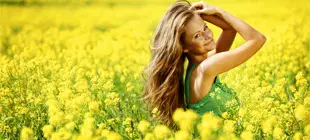The Spring Equinox is a real "New Year's Day" from an astrological point of view and gives each of us opportunities to create new projects, without waiting to put them into practice.

You will see the development of some of your dearest aspirations, thanks to the opportunities lying on your path. Destiny will give you a helping hand and this will undeniably bring you success.
Doors will open, but it will be a case of taking action in order to launch change in a concrete way. If you haven't dealt with doubts about your own worth, this is a day that will tend to awaken your awareness of what you should be able to achieve with your talents.
The abandonment of certain pleasures could distract you from responsibilities that you are going to have to face with your powerful instincts, which will be heightened over the course of the day. The challenge will be to establish a balance between self-discipline and stability on the one hand, and satisfaction and success on the other. To achieve this, don't forget that success can be just a step on the way to other larger ones, so don't give up too easily.
- Aries, Leo, and Sagittarius will find it easiest to take action.
- Gemini, Libra and Aquarius will notice an increase in creativity.
- Cancer, Scorpio and Pisces will emerge from their silence and their frankness will be effective.
- Taurus, Virgo and Capricorn will know how to cement their relationship together, to make their personal ideas progressively go down better.
What is the Equinox? What is the Solstice?
The Equinox is an astronomical phenomenon that takes place twice a year, on 20/21 March and 22/23 September. On these dates, the length of night and day is more or less identical, whatever the place on Earth. This is the only time when we are all equal (or almost) in relation to the Sun! In fact, at the Equinox, the Sun's rays are completely perpendicular to the rotation of the Earth's axis (though it is only at the Equator that the Sun is exactly at its zenith).
Reminder: the word "equinox" comes from the Latin æquinoctium, from æquus (equal) and nox, noctis (night).
In each year, there are 2 equinoxes, which traditionally correspond to the arrival of spring and autumn respectively. Depending on where you live, these equinoxes usher in the arrival of two very different seasons:
20 -21 March :
- In the northern hemisphere, the spring equinox and therefore the arrival of spring
- In the southern hemisphere, the autumn equinox and therefore the arrival of autumn
22 - 23 September :
- In the northern hemisphere, the autumn equinox and therefore the arrival of autumn
- In the southern hemisphere, the spring equinox and therefore the arrival of spring
When the Equinox is mentioned, we also sometimes talk of the Solstice. The Solstice is a half-yearly astronomical phenomenon, which also marks the passage from one season to the next: from spring to summer and from autumn to winter. The Solstices are characterised by the duration of sunshine on the Earth: This is the moment when the Sun reaches its most northerly position in relation to the Equator (the Tropic of Cancer in the north, where it is possible to see the Sun directly at its zenith at the end of June), or the most southerly (the Tropic of Capricorn in the south, where it is possible to see the Sun directly at its zenith, this time at the end of December). This means that in the northern hemisphere at the summer Solstice (on 21-22 June), it will be the longest day of the year, whereas the Winter Solstice (on 21-22 December) will be the shortest day!
Depending where you are on the Earth (northern or southern hemisphere), the dates of the Summer and Winter Solstices (just like the seasons) are reversed.
To remember
The Equinox
- marks the passing of the season from spring or autumn
- same length day and night
The Solstice
- marks the passing of the season from summer or winter
- Summer Solstice: the longest day/Midsummer and World Music Day too!
- Winter Solstice: the shortest day and longest night of the year/ also a traditional celebration day (Festival of the Sun or the Festival of Lights) in certain cultures: Indian, Jewish (Hanukkah), Roman (Saturnalia), Slav (елка) and even Christmas (originally a pagan celebration of the Sun).






